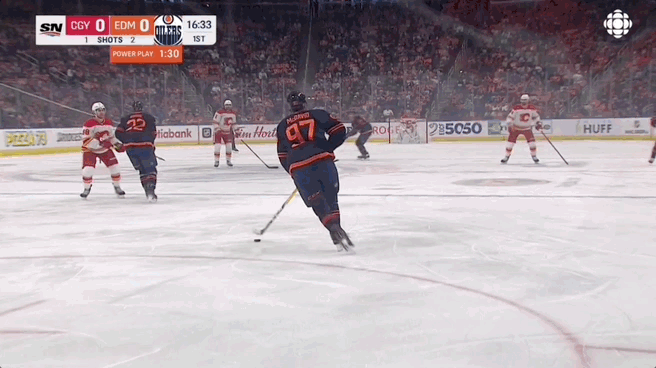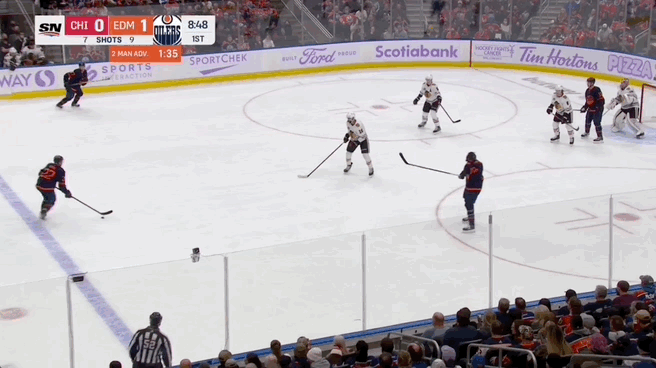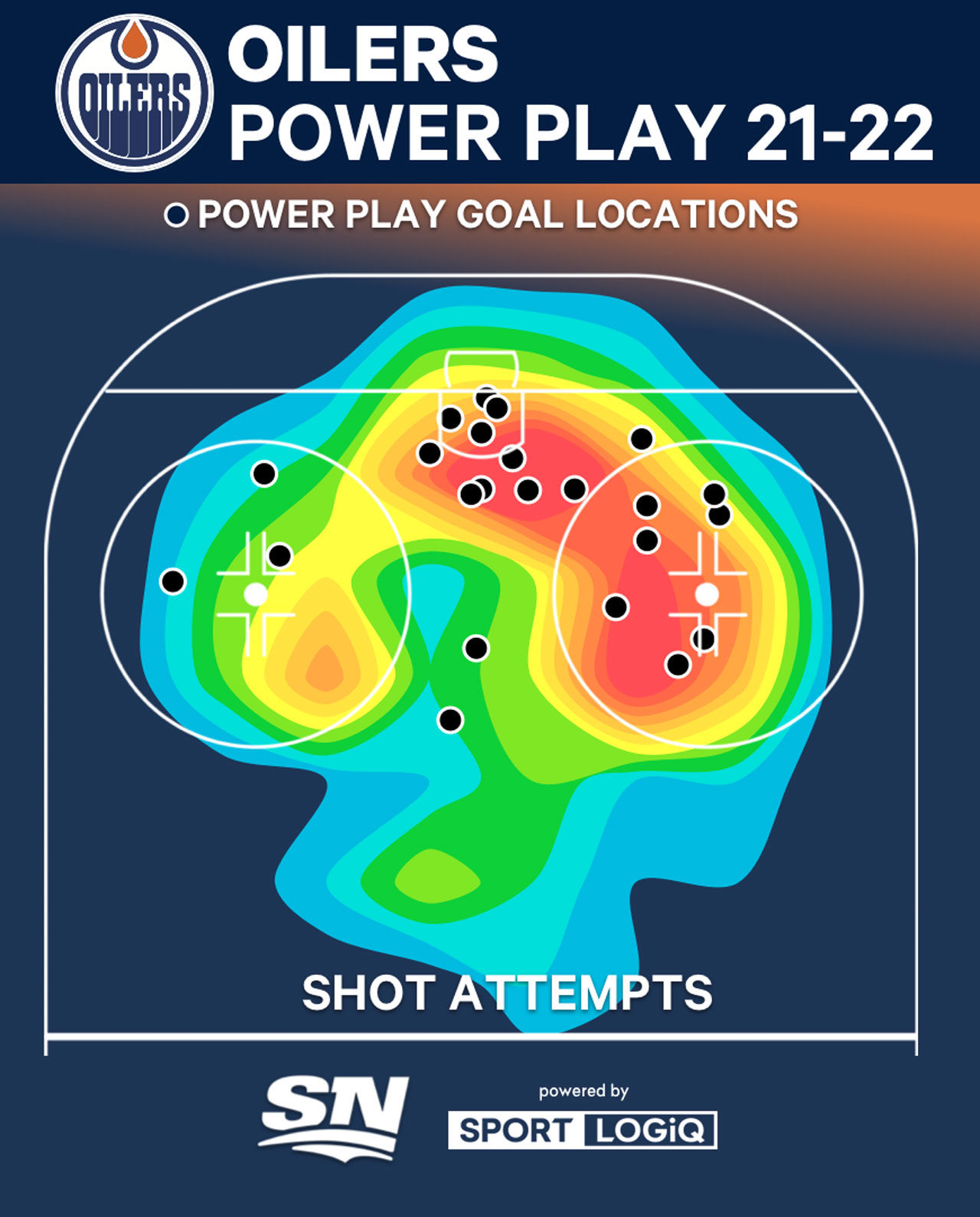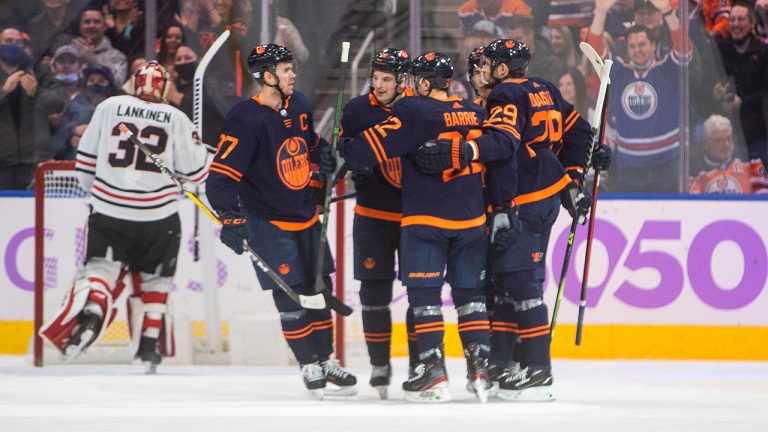The Oilers’ power play quickly became one of the hottest in the league this season. Through their first 10per cen games of the season, they led the league with a torrid 50 per cent efficiency. Now approaching the quarter-mark of the season through 19 games, they haven’t maintained that level, but still lead the league at 39 per cent — and they’re almost 10 per cent ahead of the next best (St. Louis Blues at 29.1 per cent).
So what’s made the Oilers’ unit so dangerous and is there any concern about their dip in power play percentage in November?
Few teams rely on their top unit like the Oilers’ have this season. Then again, with their success rate, they don’t always leave time for the second group to even have an opportunity. Their core players, Connor McDavid, Leon Draisaitl, and Ryan Nugent-Hopkins have skated in about 85 per cent of the available ice time which is among the most in the league. To round out that unit, Tyson Barrie’s the lone defender, while Zach Hyman and Jesse Puljujarvi have rotated to complete the forward group on that top unit.
[snippet id=5218069]
Edmonton’s usage on PP1 follows the trend, as The Athletic’s Dom Luszczyszyn explored a few seasons ago, of teams relying on their top unit. Given how top-heavy of a team they are, it pays for the Oilers to lean on their top players in these high-leverage situations.
Based on the personnel alone — led by two of the best offensive dynamo’s in the league — it’s easy to see why they’d have success. But the Oilers have had a league-average power play before with these two leading skaters. Now, they’ve found the right blend of skill sets to compose such a high-octane unit.
As the work of Arik Parnass, now director of analytics for the Colorado Avalanche, outlined, the objectives of a power-play breakout are: bringing the puck into the offensive zone, maintaining possession, and quickly getting in formation.
That’s something this Oilers team has thrived at. They lead the league in face-off percentage in the offensive zone while on the man-advantage. While research tells us that it can take a few more seconds for a team to generate a shot attempt after a draw in the zone on the power play (versus at even strength), it may be that teams aren’t just rushing to shooting — they’re taking the extra seconds to get in formation. Edmonton, who leads the lead in percentage of power play time spent in the offensive zone, is also a top-five team in percentage of face-offs won leading to a shot-on net (and seventh in a shot attempt from the slot).

When it comes to regroups, the Oilers don’t have that same frequency as other teams in controlled entry rate. But it appears that it’s because they don’t need to attempt to regroup as often as other teams. When they do attempt to cross the blue line, though, they’re quite efficient with a 67 per cent success rate (8th in the league).
There’s more to just breakouts on the power play — a team has to connect that play with another sequence to get their unit in formation and start firing shots, which Parnass’ work tells us is an important part of clicking at a high rate. The Oilers also do this really well; they’re third in breakout success rate that leads to offensive zone possession. And they’re often productive in that possession time; following their controlled entries, 39.2 per cent result in a shot on net after and 38.1 per cent convert to a scoring chance — both of which rank fourth in the league.
Who helps drive those controlled entries? One of the best transitional players in the world. McDavid, unsurprisingly, as the highest rate of carry-in attempts in the NHL on the man-advantage. In the defensive and neutral zone, his breakouts often start with a drop pass before he skates right up the ice with the puck on his stick. And he’s a top-five player in carry-ins with a shot on net or scoring chance to follow.

This isn’t a team that just relies on creating offence off the rush on the power play; rather, they’re one of the best at generating shots off the cycle, and that’s how they’ve scored a high percentage of their goals — showing the importance of getting in formation to scoring.

So where are their shots coming from? The Oilers shoot the puck a lot at the man-advantage, and they often make the best of those opportunities with quality chances as the heat map below depicts.

Edmonton’s created the third-highest rate of slot shots per 60 in the league, which is where 60.8 per cent of their shots come from. And as the data points show, it’s where some of their goal scoring has as well. Neither Hyman nor Puljujarvi are the most frequent shooters on the man-advantage, but when they do shoot, it’s generally from the slot — the same goes for Nugent-Hopkin whose taken 75 per cent of his shots from that area of the ice. It’s also where McDavid and Draisaitl have shot from about 60 per cent of the time.
That’s what makes them so tough to defend; there are multiple shooting options who all can drive to the quality parts of the ice.

Shot location is just one piece of the puzzle. Pre-shot movement also helps determine the danger of a shot. Edmonton’s precise with their passes, they’re second in the league with 85.2 per cent of their attempts being successful. And no one sends more passes to the slot than the Oilers.
That passing also tees up quick one-timers, which are one of the more dangerous shots on the man-advantage. Generally, those one-timer attempts come from Draisaitl (on his off-wing) and his lethal shot, as well as defender Barrie — the former obviously having far more success converting.

Even McDavid has increased his one-timer attempts, a shot he generally hasn’t leaned on during his career. While he doesn’t attempt it nearly as often as his teammates, just having that option in his arsenal adds another threat.
What helps is just how many players on this unit can move the puck. McDavid’s obviously one of the best puck distributors; he often sets up his teammates for those one-timers and slot shots with his quick thinking, speedy reactions, and deceptive plays. Barrie at the point also helps
facilitate play from the point with his passing. Plus, Draisaitl, who is often expected to shoot, is a skilled passer, as is Nugent-Hopkins.
The fact that any of these players can pass or shoot makes them all the more dynamic. With so many options, and capable passers, the Oilers’ power play isn’t always predictable despite developing some tendencies.
As effective as the Oilers have been, should we expect a regression — especially after their percentage slid from where it was a month ago?
[snippet id=3816507]
Even though the Oilers’ power play percentage has dipped by 11 per cent from their first 10 games, their efficiency is still so impressive. For context, no team, since power play percentage started being recorded, has finished with a 39 per cent efficiency. And to keep things more ‘level,’ no team has salary cap has even come close — the next best are the 2019-20 Oilers (29.5 per cent), 2018-19 Lightning (28.2 per cent), and 2012-13 Capitals (26.8 per cent).
Just because it’s never been done doesn’t mean it’s impossible. Still, it’s going to be tough for Edmonton to sustain this level, even though they’re playing well below the surface and have elite finishing talent. Teams know to study Edmonton’s tendencies because their power play is such a threat, and that’s obviously going to challenge them as the year rolls on.
And, the Oilers are outscoring their expected goal rate of 12.3 per 60 which can be an indication that a regression could come. But there’s also their finishing talent to consider on top of that. Shooting ability isn’t always everything — this team has had an average power play before with both McDavid and Draisaitl seasons ago — but now they’re combining that elite skill and strong offensive generation below the surface.
So even if their percentage does slip from this sky high level, this Oilers’ electric power play could very well lead the league all season long, and should remain a strength.
Data via Sportlogiq





